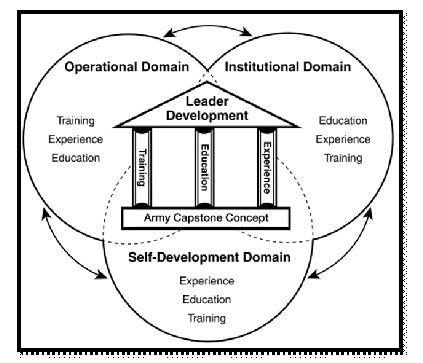The American Army is the greatest military in the world and whose greatness comes from the strategic approach of training all the soldiers to become leaders. Each soldier, at one point, becomes a leader whether the forces are in war or peacefully at home (Kirchner, 2018). The structure of the courses is such that those offered at the start of an officer’s career primarily focus on training to equip the soldiers with skills they need certainty. However, the courses become weightier with time and focus on education to prepare them for uncertainties. Training leaders improve their skills to lead their fellows in turns efficiently. Moreover, a soldier’s experience, education, and training play crucial roles in their development in the military. A proper mix of training, education, and experience becomes crucial to officers as they scale the military ranks and make vital decisions that catapult the army to greater achievements.
Leadership is vital in the army because it enables the force to accomplish its objectives. Developing leaders is a task that begins immediately after the military enlists a person for service and shapes the individual as they grow in their career. Kirchner (2018) indicates that leader development entails a deliberate, continuous process embedded in the military values, growing soldiers to become professional leaders with mature character. Thus, an army leader requires progressive education, training, and experiences available in institutions, operations, and self-reflective spaces, each anchor on the relationships with peers and trainers (Flowers, 2018). Moreover, leader development results in confident and skillful leaders who act on well-informed decisions that protect the military’s reputation and keep their teams safe (Flowers, 2018). It is a shared responsibility between the individual and the institution, enabling the passage of the experiences the U.S. military gained in the wars in Afghanistan and Iraq to new soldiers through training and educating new soldiers to become ready for more complex wars in the future. The diagram shown in Figure 1 shows the relationship of the three levels of leadership development, based on the operational domain, institutional domain, and self-developmental domain.

The U.S army replaced the Structured Self-Development with the Distributed Leader Course while using the U.S. Army Training and Doctrine Command to create six leader reference points for awarding core competencies to those who attain the set goals. The six areas comprise communications, readiness at all levels, leadership skills, training management, program management, and army and joint operations (Greer, 2018). The force has also strengthened its Professional Military Education (PME) to focus on equipping leaders with tactical and technical proficiencies in personal tactics, techniques, and procedures relating to their rank and organizations. PME also focuses on building an individual officer’s system, creative and critical thinking, decision-making skills, and complicated approaches to problem-solving. Moreover, PME also considers it crucial to develop the characters of each leader and their morality and ethics, which prepare them for future ranks where they are responsible for more complex responsibilities (Greer, 2018). In addition, PME equips leaders with the skills necessary to make them transformational leaders who can create change in the military, making the army respond to various dynamics of war and technology.
The U.S military also implemented a program called the Army Profession, and Leader Development Forum (APLDF) meant to explore the various problems that affected the development of leaders, thereby creating solutions for them. The APLDF was created to ensure a systematic approach toward rebalancing the three concepts of army leader development. Thus, the program ensures that the training, education, and experiences align with the leaders’ expected challenges. The forum currently focuses on four primary areas, which upon completion, an officer becomes aware of international broadening concepts and the U.S. army professionalism, among others. APLDF has also achieved officers’ career tracker, assessment and feedback initiatives based on multiple sources, high-level strategic policy and planning, and command and general staff officers.
In conclusion, the current army environment is limited by resources, which calls for the need to invest in training and educating leaders to develop and equip them for leadership positions, which can help them mitigate various shortfalls. Effectively training army leaders at the top military positions enable them to be adaptive thinkers who can use the resources they have to overcome challenges facing their teams. Education enables officers to be critical thinkers, thus outsmarting opponents in war and uncertainties in tactical combat. Therefore, it is crucial to improve the thinking skills of the leaders to enable them to become operational experts with top-level skills for planning, preparing, and executing successful large-scale operations in their specific missions. The leader development program must cover several areas and topics, such as complex problem-solving skills, creative thinking, strategic thinking, critical assessment and decision-making skills, and design and system thinking. Therefore, leader development must entail a proper mix of training, education, and experience that become more complex as one scales the ranks in their military career.
References
Greer, J. (2018). Thoughts on military education, training and leader development in 2050. Small Wars Journal.
Flowers, M. (2018). Improving strategic leadership. In Military leadership (pp. 233-244). Routledge.
Fukuzwa, M. (2016). Processing leader development. Small Wars Journal.
Kirchner, M. J. (2018). Veteran as leader: The lived experience with US Army leader development. Human Resource Development Quarterly, 29(1), 67-85.